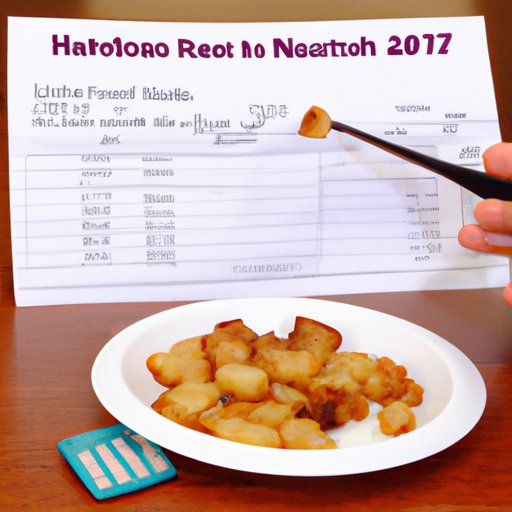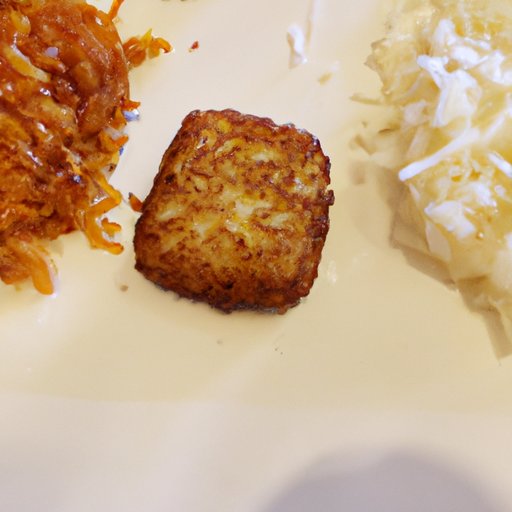Introduction
Hash browns are a popular breakfast food that is often served with eggs, bacon, or sausage. They are made from shredded potatoes that are fried in a pan with oil or butter. The potatoes are usually seasoned with salt and pepper, and they can also be topped with cheese, onions, or other ingredients. Hash browns have been around since the 1930s, when they were first served in diners and cafes as a side dish. Over the years, they have become a staple of the American breakfast plate.
But what about their nutritional value? Are hash browns good for you? This article will explore the nutritional benefits and risks of consuming hash browns. We’ll look at the vitamins, minerals, and macronutrients found in hash browns, as well as how they compare to other breakfast foods. We’ll also discuss ways to make healthier hash browns at home, different types of hash browns, and how to choose the healthiest option when eating out.

Examining the Nutritional Value of Hash Browns
Hash browns are a source of many essential vitamins and minerals. They are also a source of carbohydrates and protein. Let’s take a closer look at the nutritional value of hash browns.
Calories and Macronutrients
A serving of hash browns contains about 200 calories. It also provides 11 grams of fat, 24 grams of carbohydrates, and 4 grams of protein. This makes it a relatively balanced meal, providing enough energy to keep you going throughout the morning.
Vitamins and Minerals
Hash browns are an excellent source of vitamin C, which helps protect your cells from damage caused by free radicals. They also provide small amounts of other vitamins and minerals, including calcium, iron, magnesium, phosphorus, and potassium. These nutrients are essential for strong bones, healthy muscles, and a robust immune system.
Comparison to Other Breakfast Foods
When compared to other breakfast foods, such as oatmeal, cereal, and toast, hash browns offer a slightly different nutritional profile. Oatmeal is higher in fiber and protein, while cereal is higher in carbohydrates. Toast is lower in calories and fat, but higher in carbohydrates. All three are good sources of vitamins and minerals, but hash browns provide the most balanced combination of macronutrients.
How to Make Healthier Hash Browns at Home
If you want to enjoy hash browns without all the added fat and calories, there are a few simple steps you can take. First, use a light cooking oil like olive oil or canola oil instead of butter. Second, opt for fresh potatoes over frozen hash browns, as they contain fewer additives. Third, consider adding vegetables to your hash browns. Onions, peppers, mushrooms, and spinach are all excellent additions.
Finally, consider baking or roasting your hash browns instead of frying them. Baking or roasting requires less oil and yields crunchy, delicious hash browns. To bake hash browns, combine shredded potatoes with olive oil and seasonings, spread them on a baking sheet, and bake for 25-30 minutes at 375°F.

Exploring Different Types of Hash Browns
There are several variations of hash browns available. Traditional hash browns are made with white potatoes and are usually fried in butter or oil. Sweet potato hash browns are made with sweet potatoes and are usually baked or roasted. Other types of hash browns include hash brown casseroles, hash brown patties, and even hash brown waffles.

The Benefits and Risks of Eating Hash Browns Regularly
Eating hash browns regularly can bring many health benefits. They are a good source of vitamins and minerals, and they provide a balanced combination of carbohydrates, proteins, and fats. Eating hash browns can also help you feel fuller for longer, making it easier to manage your weight.
However, there are some risks associated with eating hash browns. As mentioned earlier, hash browns are high in fat and calories. Eating too much can lead to weight gain, so it’s important to watch your portion sizes. Additionally, if you opt for the traditional fried version, the high fat content can increase your risk of heart disease.
Finding the Healthiest Option When Eating Out: Hash Browns or Something Else?
If you’re eating out, there are still ways to make sure you’re getting a healthy breakfast. Start by comparing different menu items. Many restaurants offer healthier alternatives to hash browns, such as oatmeal, fruit, and yogurt. If you do decide to go with hash browns, consider ordering a side portion instead of a full plate. This way, you can enjoy the flavor without overdoing it on the calories and fat.
Conclusion
Hash browns can make a great addition to a balanced breakfast. They are a good source of vitamins, minerals, and macronutrients, and they can be a satisfying way to start your day. However, it’s important to be mindful of portion sizes and cooking methods. By following the tips outlined in this article, you can enjoy hash browns as part of a healthy lifestyle.
(Note: Is this article not meeting your expectations? Do you have knowledge or insights to share? Unlock new opportunities and expand your reach by joining our authors team. Click Registration to join us and share your expertise with our readers.)
